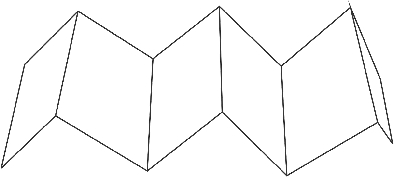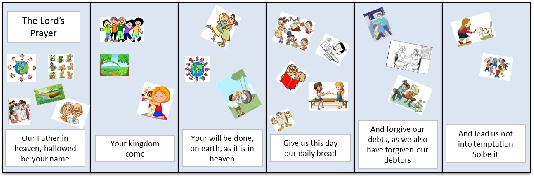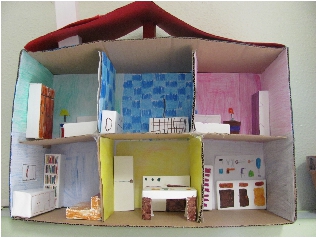Collaboration in the family III
First: Welcome the children into the session. Say how happy we are to see them and how important they are for the class.
The volunteer will do the opening prayer.
Second: Raffle Box of Prayers. The volunteer will introduce the “Raffle Box of Prayers”. In your turn, each child will open the box, choose one prayer and read it loudly for the whole class. We will do it until all the kids have their chance to choose and read a prayer.
Third: Activity – Doing our own book of prayers. The volunteer will tell the children that each one of them will do their own book of prayers that they can take home and pray together with their families. Each class they will do one different prayer. The volunteer will show them one example of her/his own, and ask them to do their own by colouring the picture and filling the gaps by writing the missing words in the prayer. When finished, every child will read the prayer. At this point, the volunteer can ask more than one child to read different parts of the prayer.
Fourth: Activity - The Lord’s Prayer booklet. The volunteer will ask the children if they know the Lord's Prayer and invite them to create their own prayer booklet. All children will be doing the activity together. For that, the volunteer will read the prayer and discuss with them each part of it. The older kids will be responsible to find the sentences that are scrambled and put them in the correct order in the booklet, and at the same time, the younger children will find the figures that match the numbers in the booklet. The volunteer will then ask each child about the picture they selected and discuss with them its connection to the prayer. They will attach the pictures as they prefer and this goes on until they finish the booklet.


When the booklet is complete, all children can read together the prayer, and the volunteer will ask if they want to take the prayer booklet to their home for a week, so every class, one child will have the opportunity to take the booklet home to read and share with their family, and they are responsible to bring the booklet in the next week for another child's turn to take it home. (An example of how the booklet could be done is attached in the end).
Fifth: Activity - Making our own house – Model using recycled objects. The volunteer will bring several recycled objects so the children can build up a model of a house. The volunteer will ask the children what they can do to help their parents in each part of the house. For example, in the kitchen, they can help washing the dishes and doing the table. For each room, the volunteer will bring pictures of children helping their parents, so they can also place those pictures inside the model. During all the activity, the volunteer should discuss with them how important it is to help each other at home, but also at school, and wherever they are. (An example of what can be done as a house model is attached in the end).

Sixth: Activity – Helping and “not helping” (Helping or not / Being helpful or unhelpful / Jesus’ helpers). The volunteer will divide the children in two groups, but always mixing up older and younger children together so they can help each other. One group will have its turn to create a mess in the classroom, putting a lot of objects out of their place. The other group will be the “Jesus’ helpers” (they will receive a heart with a draw of Jesus on it), and they will have to identify which objects are out of place and, at this point the volunteer should discuss with them how they feel when they arrive into a place that it is messy and dirty, etc... and what can they do to help. The volunteer will also discuss with them the fact that they can also help their parents at home and the teacher at school. Once the discussion is over, the Jesus’ helpers group should put the objects back into the correct place. Then, the groups swap to achieve the same goal.
Seventh: Video – The parable of the good shepherd.
Extra activity 1: Team work (15min)
The volunteer will separate the children into pairs, where an older child will be together with a younger one. One of them will be blinded with a scarf. The other one will be responsible to guide and give directions to the partner in order to find a given object. When they find the object, the children will swap places. During all the game they should be together and helping each other. We should advise them to whisper the directions into the other child's ears to avoid shouting in the room. In the end of the activity, the volunteer should ask the children how they felt during the game knowing that there was someone helping them and showing the best way to find what they needed. The volunteer should help them realise how good it is to cooperate and work together with friends, family, at home, at school, etc.
Extra activity 2: Reading and discussing the Gospel books together.
Eighth: Healing Theatre. Prepare the kids for the healing time. The volunteer will put one chair at the centre of the room and invite 1 child at a time to sit down and play: “Simon says”. The child sat on the chair will have to think about 1 example of good behaviour and 1 of bad behaviour during the healing time and tell the other children to do what he/she says. After each example, the volunteer will ask the rest of the children to decide if that was a good or bad behaviour by showing them two signs of a “happy or sad face”.
Ninth: Closing prayer - One of the children will do a closing prayer; encourage the children to volunteer for this task. If they don’t want to collaborate we could say we will follow the letters of the alphabet. The child’s name that starts with the letter A will do the opening prayer this time. Everybody will have the chance to collaborate.
Suggested activity to be given as Homework.
Closing prayer
Class suggested being suitable for: Kindergarten (5 to 6 years old).
Spiritist volunteer: Juana Castro, London, linked to The Spiritist Psychological Society.


[Classes]
|
[Print]






